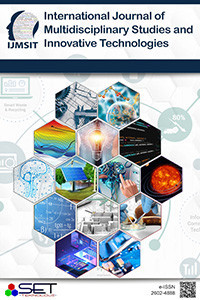Enhancement Trust Management in IoT to Detect ON-OFF Attacks with Cooja
Enhancement Trust Management in IoT to Detect ON-OFF Attacks with Cooja
Trust management, IoT, ON-OFF attacks, Artificial Neural Networks Security, Contiki OS,
___
- [1] J. Henrique, “Mitigating On-Off attacks in the internet of things,” Inter. J. Dis. Sensor Networks, pp.1-8, DOI.10.1155/2015/859731, November 2015.
- [2] A.V., P. Zhang, “Trust management for internet of things,” J. Net. Comp., pp.120–134, Appl. (42), 2014.
- [3] Ray, S. K., Gutierrez, Airehrour, “Secure routing for the internet of things,” A survey. J. Net. Computer App., 66,198-213, 2016.
- [4] R. Giraud, L. Atzori, M. N., “Trustworthiness management in the social internet of things,” IEEE Transl. Data Manage, 26 , pp. 1253–1266, May 2014.
- [5] Y. Saied, D. Zegh., M. Laurent, A. Oli., “Trust management system design for the internet of things,” context-aware and multi-service appro., 39, pp. 351–365, 2013.
- [6] A. Shenfield, D. Day, A. Ayesh, “Intelligent IDS using ANN,” ICT Express,pp.95.99,DOI:https://doi.org/10.1016/j.icte.2018.04.003,2018
- [7] Abderrahim, & Elhedhili, “Trust management system mitigating On-Off attacks and dishonest recommendations for the Internet of Things,” DTMS-IoT, 2016.
- [8] F. Bao, I.R. Chen, J. Guo, “Adaptive and survivable trust management for the community of interest-based internet of things systems,”11th Inter.Symp. on Auto. Decent.Sys., Mexico,2013.
- [9] C. Mendoza, J. Mendoza, “mitigating on-off attacks in the internet of things using a distributed trust management scheme,” Inter. J. Dis. Sens. Net., Article 859731(11), 2015.
- [10] D. Chen, G. Chang, D. Sun, X. Wang, “Trust management model based on a fuzzy reputation for the IoT,” TRM-IoT, Comput. Sci. Inf. Syst., pp.1207–1228, April 2011.
- [11] W. Khreich, B. Khosravifar, A. Hamou-Lhadj, and C. Delhi, “An anomaly detection system based on variable N-gram features and one-class SVM,” Info. and Sof. Techno., vol. 91, pp. 186–197, 2017.
- [12] K.Costa, J. Papa, C.Lisboa, “Survey on machine learning-based intrusion detection approaches,” IoT ,Compu. Net., PII: S1389-1286(18)308739, DOI:https://doi.org/,10.1016/j.comnet.2019.01.023, 2019.
- [13] M. Apte,S. Kelkar, A. Dorge ,S. Deshpande. Bomble ,A. Dhamankar, “Gateway based Trust Management System for Internet of Things,” ISSN: 2237-0722, Vol. 11 No. 4 (2021), August 2021.
- [14] Contiki Operating System for the Internet of Things, Online Available: HTTP:// www.contiki-os.org/.
- [15] Azure Microsoft for ML, Online Available: https://studio.azureml.net/.
- ISSN: 2602-4888
- Yayın Aralığı: Yılda 2 Sayı
- Başlangıç: 2017
- Yayıncı: SET Teknoloji
Sentiment Analysis of Users’ Reactions to Deadly Disasters Posts in Turkey: Facebook Data
Data Driven Software Testing with Selenium Apache POI Tool
Ecem İREN, Gizem İREN, Aylin KANTARCI
The priorities and comfort of the smart home
Şebnem BORA, Gizem CENGİN ÜNÜVAR, Sevcan EMEK
Synthetic Skin Cancer Image Data Generation Using Generative Adversarial Neural Network
Burak BEYNEK, Şebnem BORA, Vedat EVREN, Aybars UGUR
Modelling Shared Co-owned Data Flow in Online Social Networks by Formal Methods
Enhancement Trust Management in IoT to Detect ON-OFF Attacks with Cooja
